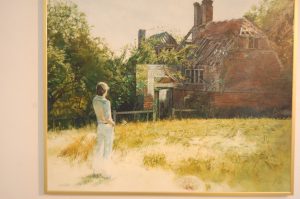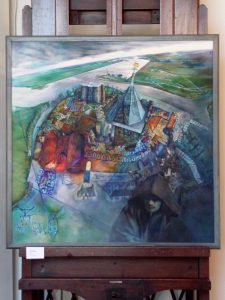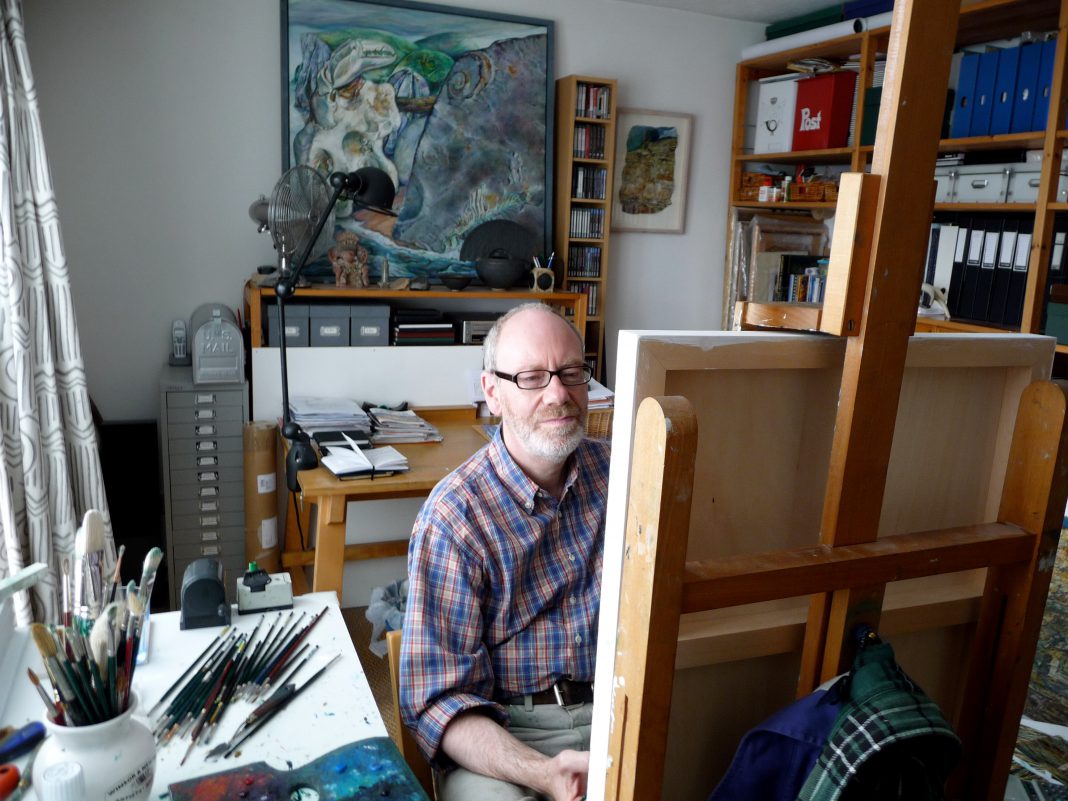The retrospective exhibition,”View from The Strand”, at the Rye Art Gallery from January 20 to March 4, has given me the opportunity to bring together paintings and drawings representing forty five years of working in my home town. Since 1989, this has been from my studio on the Strand.
Although one painting, “Weatherwatch: View from The Strand”, shows the actual view from my studio, the other works in the exhibition reflect how I see Rye, its environs and, in four instances, the Sussex downland and Wealden landscapes.

The linking theme is that of time, whether historic, seasonal or transitory. Thus in “Time Pageant”, an old map of Rye is changed to incorporate elements of the town of today and figures drawn from recent Rye Fawkes processions. “The Dragonfly Path”, painted one summer, hints at a ruined farmhouse’s past and two fairground paintings, “Star Man” and “Fairground Aurora”, suggest a fantasy world that arrives in the town only to disappear a week or two later.
A recurring image from when I was a student to the present day has been Winchelsea’s much missed St. Leonard’s windmill, brought down in the Great Storm of 1987. I returned to it again at the end of 2017 in “The Turning Year”, a painting that refers to the seasons.
The fascination that natural forms have for me is also represented in the exhibition. Sea-worn wood, stone, shells, fossils and a crab’s claw appear in “Drift Wood”, “Shore Forms” and in a small three-dimensional piece that incorporates some of the objects that occur in these two paintings.

The majority of works in “View from The Strand” are oil paintings but some include three dimensional elements. “Going South”, for example, can be opened up to reveal the imagined interior of a (now demolished) snowbound house in Military Road. The scrubbed and painted wood of “Shore Monolith: Night” represents the groynes that once divided the shingle at Pett Level. In other works, there are paper casts (overlaid and glued paper), taking on the form and texture of stone, then primed and painted. And in “Reclaimed Lands”, a frottage technique – direct rubbings from the walls of Camber Castle using paper and graphite – created initial texture into which I painted with oils to define the subject. Frottage also appears in areas of “Path to the Sea”, “Winter Solstice, Berwick, Sussex” (both pencil) and “Eccentric Harvest” (pastel and pencil).
Although my family’s move from Hove to Rye when I was ten was at first unwelcome, (my father was in the police so we had no choice!), it turned out very well for us all and especially for me, creatively. The history and character of the town and the proximity of a fascinating and varied landscape quickly drew me in, and after one year at Rye Primary School, I had inspirational art teachers in Kitty French and Jill Elliot at Rye Grammar School.
There is a saying I believe, that Rye is a place that one always comes back to (if one ever leaves!) which is what I did after Art College in 1971. At Kitty’s suggestion, I submitted my work to and was elected a member of the Rye Society of Artists in 1972. That, and the fact that we have the superb Rye Art Gallery, which has offered me many opportunities to exhibit over the years and the advantage of having been given permission through my work to explore Rye behind the scenes – from the attic in the Town Hall to Patric Dickinson’s writing room (this appears in “Rye Fragments: Levels”) – would indeed make it very hard to leave!
Photo: David Crew




This is a wonderful exhibition and not to be missed. David has an amazing imagination and I have been a fan of his for many years. Each painting slowly reveals hidden aspects and you really need to spend time looking closely to appreciate all the detail and the hard work that goes into completing something as unique as Going South.
I really enjoyed reading about David’s background and what inspires him to paint and it’s a lovely idea to include images of old buildings long gone, but not forgotten.